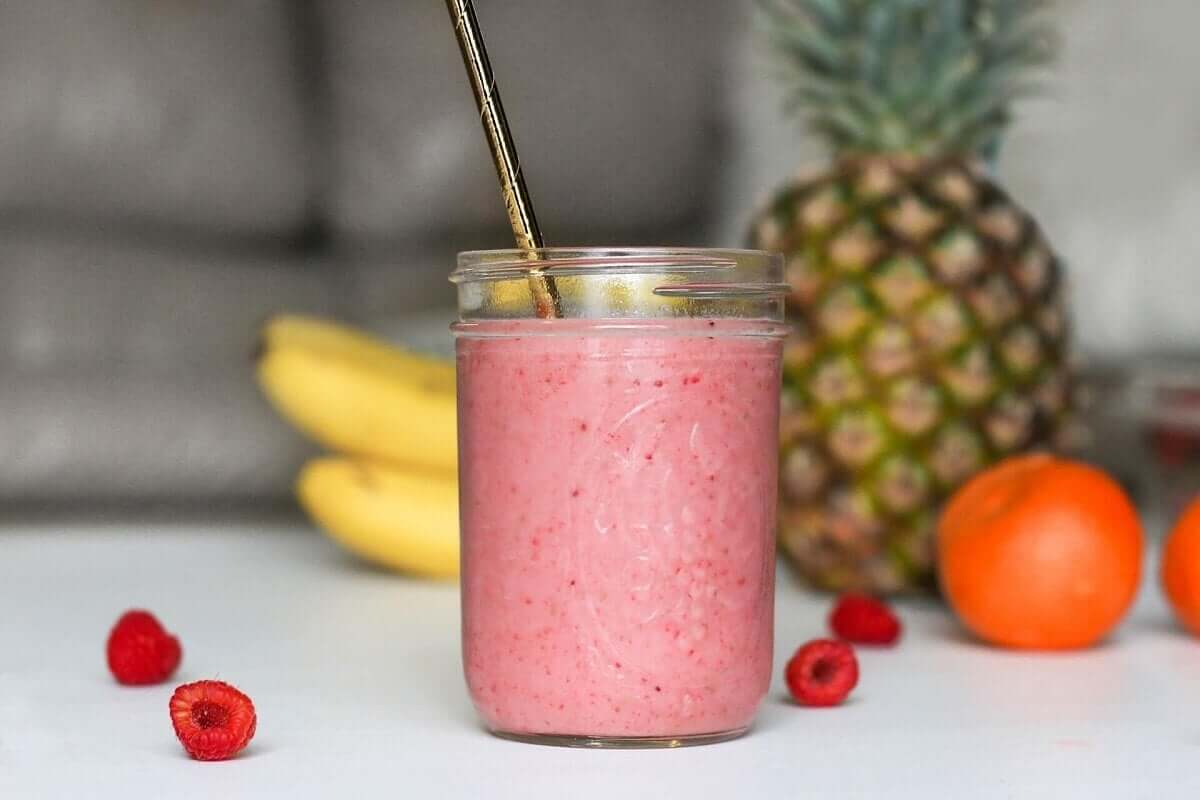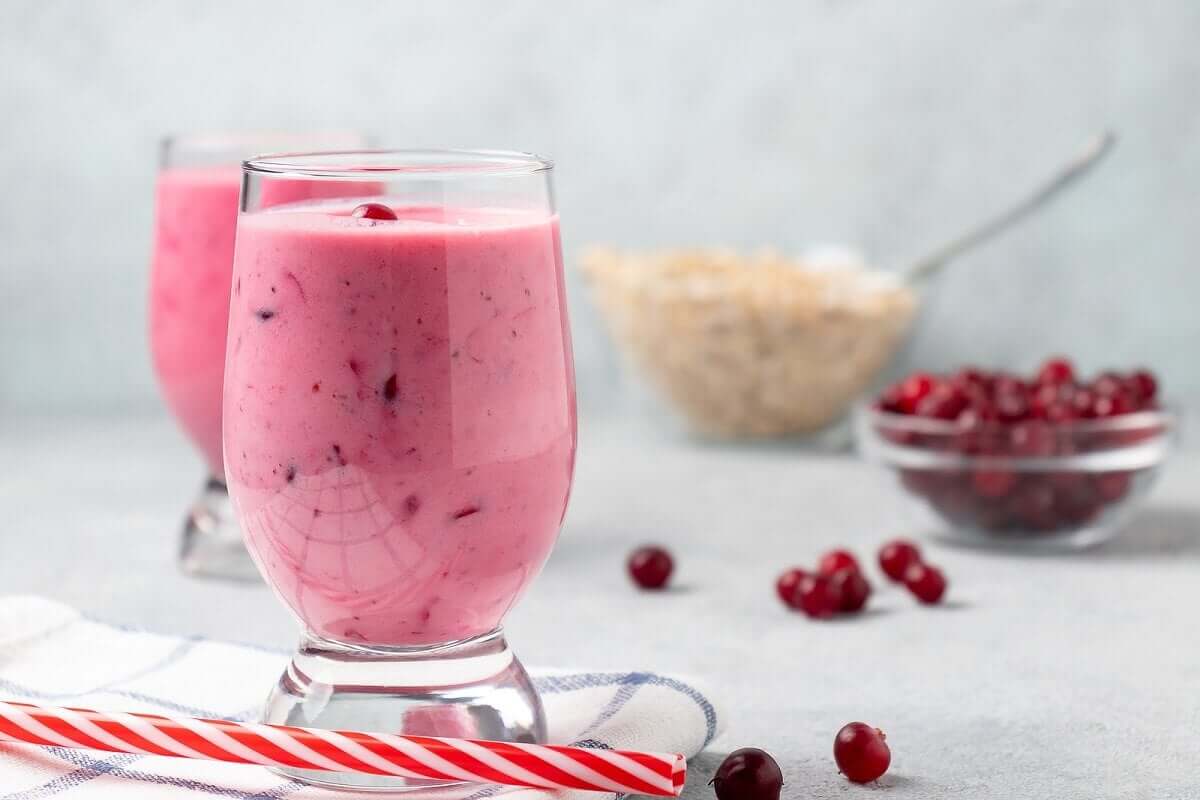Fruit and Yogurt Smoothies: Why Make Them?


Written and verified by the nutritionist Saúl Sánchez Arias
When correctly included in a diet, fruit and yogurt smoothies can give you certain health benefits. However, their misuse can cause negative consequences, especially if you make mistakes in how you prepare the smoothies. Choosing the right ingredients and their combination is essential.
Within a healthy eating plan, almost all foods can be included. One of the keys to ensuring variety in a satisfactory way is to be precise in the quantities of each of the products that you consume. This, of course, must be taken into account when drinking smoothies as well.
Characteristics of fruit and yogurt smoothies
Among the characteristics of fruit and yogurt smoothies, we can’t help but mention the presence of probiotics and antioxidants. The former have been shown to have a positive effect on the intestinal microbiota, resulting in improvements to overall health.
In particular, they contribute to improving the immune system which reduces the risk of infectious diseases. On the other hand, antioxidants are essential substances to neutralize the production of free radicals at the cellular level.
Thus, they maintain the oxidative balance, reduce the risk of premature aging and the incidence of many chronic diseases. This was shown by a study published in the magazine Clinica Chimica Acta, which concluded that consuming these substances regularly is related to a better state of health.
Nor can we forget the protein contribution of these smoothies. They include proteins of high biological value, with all the essential amino acids that the body can’t make on its own.
According to experts, an adequate intake of these nutrients is associated with a lower risk of developing problems that compromise muscle mass. One of the most serious problems it avoids is sarcopenia.

You may like: Do Fruits Prevent Weight Loss?
How to properly make them
There are a number of considerations to take into account when making fruit and yogurt smoothies. The first one is that it’s essential to use the whole fruit, not only its juice. Thus, a slower gastric emptying is ensured due to the presence of fiber, which reduces the impact of fructose on metabolic health and on blood glycemia.
On the other hand, it’s always advisable to opt for fruits with bright colors, such as berries. These have a greater amount of phytonutrients with antioxidant capacity, since they’re mostly pigments. Therefore, we can maximize our overall health with the contribution of substances with beneficial effects.
Lastly, you should always monitor the quality of yogurt to be included in the shake. The best option is to use a natural one, even a Greek yogurt if greater density is needed and the diet doesn’t present a low-calorie character.
In any case, we recommend avoiding sweetened versions. Sugars are harmful because they increase pancreatic stress. Sweeteners, on the other hand, do so by modifying the intestinal microbiota.
Keep reading:7 Ways to Reduce Added Sugar in Children’s Diets
When to consume fruit and yogurt smoothies
The best time to consume fruit and yogurt smoothies is in the afternoon. During breakfast and at night, the body isn’t as prepared to metabolize sugars due to the action of circadian rhythms that control hormone production.
However, in the mid-afternoon, the body generates the best processing of carbohydrates, thus reducing the negative impact of carbohydrates on health.
In addition, because they contain fiber and protein in their composition, the fructose in fruit smoothies and yogurt won’t be absorbed quickly. Thus, glycemia is stabilized and the pancreas isn’t over-excited.
Other great ingredients to include
Besides fruits and yogurt, there are other ingredients that can complement these smoothies in a fantastic way. Both the nuts and seeds can increase protein content, as well as providing high-quality fatty acids.
On the other hand, including culinary spices is a great idea. There’s one that works especially well in these cases: cinnamon. This spice has the property of being beneficial in reducing the risk of developing type 2 diabetes.
It’s even a good idea to add pure cocoa or coffee. Both elements have a high number of phytonutrients with antioxidant character. They can exert a positive effect on cardiovascular health by reducing blood pressure.
In addition, they’ve also demonstrated to help prevent aging and the formation of free radicals.

Including fruit and yogurt smoothies in your diet
Although they may not be the best choice at any hour, including fruit and yogurt smoothies in your diet can provide you with the positive nutrients for health. This isn’t an optimal choice for your daily diet, although smoothies do often appear in diet plans.
The key to maximizing their effects is to correctly choose the fruits that you include, as well as the yogurt that you’ll use to make it. In addition, with the aim of providing added value you can try to include nuts or spices in the preparation.
Keep in mind that the basis of a good diet is variety. Drinking these smoothies as a snack can generate a positive effect, thanks to the contribution of antioxidants, probiotics, proteins and lipids. However, always try to avoid the industrial versions; prepare them at home to ensure their quality.
All cited sources were thoroughly reviewed by our team to ensure their quality, reliability, currency, and validity. The bibliography of this article was considered reliable and of academic or scientific accuracy.
- Sánchez B., Delgado S., Blanco Míguez A., Lourenço A., et al., Probiotics, gut microbiota, and their influence on host health and disease. Mol Nutr Food Res, 2017.
- Chang KH., Cheng ML., Chiang MC., Chen CM., Lipophilic antioxidants in neurodegenerative diseases. Clin Chim Acta, 2018. 485: 79-87.
- Martone AM., Marzetti E., Calvani R., Picca A., et al., Exercise and protein intake: a synergistic approach against sarcopenia. Biomed Res Int, 2017.
- Takahashi K., Ishigami A., Anti aging effects of coffee. Aging, 2017. 9 (8): 1863-1864.
This text is provided for informational purposes only and does not replace consultation with a professional. If in doubt, consult your specialist.








